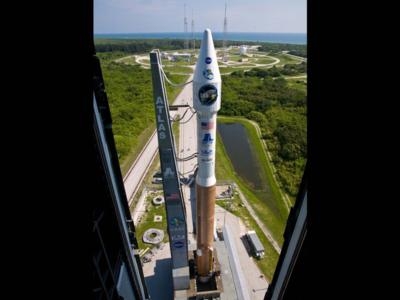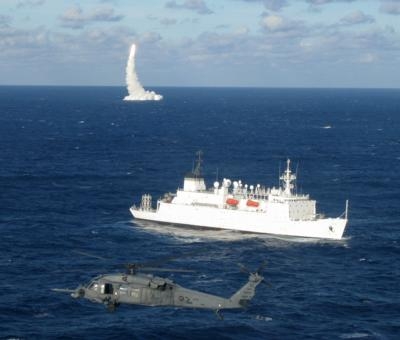Anti-Collision System Similar To Airliners Helps AF Personnel Clear Launch Ranges
The 45th Space Wing successfully launched a communications satellite onboard an Atlas V rocket from Cape Canaveral Air Force Station on May 4. As the rocket lit up the sky and was hurled into space, personnel from the 920th Rescue Wing stood by and watched, knowing their part of the mission had already been accomplished.

The 920th RQW, Air Force Reserve Command's only combat search-and-rescue wing, cleared the range prior to the rocket launch. Clearing the range is an essential task, said Lt. Col. Robert Haston, but people are sometimes confused as to what that actually entails. "The way people normally say it is that we're there to get boats out of the way of the launch, but really that's sort of backwards; most boats are going somewhere, so we try to keep boats from coming in the way of the rocket path when it goes off," said Haston, an HH-60G Pave Hawk pilot and chief of safety for the 920th RQW.
The importance of keeping the range clear is ensuring nobody is injured during a normal launch or--worst case scenario--if something goes wrong with the launch. "If there are any boosters coming off the rocket, then we know things are going to hit certain places in the ocean, so we need to absolutely make sure there's nobody anywhere near those," Haston said. "In the event of a malfunction... hundreds of thousands of high-speed debris is going drop into the ocean."
Keeping people and boats clear of any possible highly-dangerous debris has been a mission for the 920th RWQ since 1995, Haston said. The wing also cleared the range and provided for NASA's astronaut rescue and recovery support during space shuttle launches and landings from 1961 to 2011. As time passes, Haston said the range clearing mission itself remains largely the same, but the technology used to accomplish it evolved and has led to greater efficiency. Haston said when the wing began range clearing missions in the 90s, the pilots relied on their eyes to spot boats, then notify them to stay out of the rocket's or shuttle's path. While overall successful, there were imperfections in this practice. "If there are rain showers, particularly in Florida summers... if a boat's on the other side of the rain shower, you're not going to see it," Haston said.
He said the Automatic Identification System (AIS) changed all that. "AIS is sort of like the anti-collision system that airliners have," he said. "[the systems] all keep track of where boats are, where they're going, speed, et cetera. Receivers feed our portable computers to track ships' movement. It's amazing."

He said AIS allows 920th personnel to determine where any boat in the area would be at launch time. If the system determines a boat would be in the rocket's path, 920th personnel warn the boaters to turn around or change course. "What's nice is when they turn, you can see them [on the computer]," Haston said. "Back in the day, they'd turn while we were looking, then they'd turn back [into the rocket's path] later."
With AIS and other constantly evolving technology, the 920th RQW efficiently continues its partnership in and support of the 45th SW's rocket launch missions and more, now and will for years to come.
(Images: Upper, an Atlas V booster moves towards the launch pad. Lower, Two HH-60G Pave Hawk helicopters patrol the safety zone during a rocket launch in December 2011. USAF Photos)
ANN Salutes Staff Sgt. Anna-Marie Wyant, 920th Rescue Wing Public Affairs
 ANN's Daily Aero-Term (04.20.24): Light Gun
ANN's Daily Aero-Term (04.20.24): Light Gun Aero-News: Quote of the Day (04.20.24)
Aero-News: Quote of the Day (04.20.24) ANN's Daily Aero-Linx (04.21.24)
ANN's Daily Aero-Linx (04.21.24) Aero-News: Quote of the Day (04.21.24)
Aero-News: Quote of the Day (04.21.24) ANN's Daily Aero-Term (04.21.24): Aircraft Conflict
ANN's Daily Aero-Term (04.21.24): Aircraft Conflict




